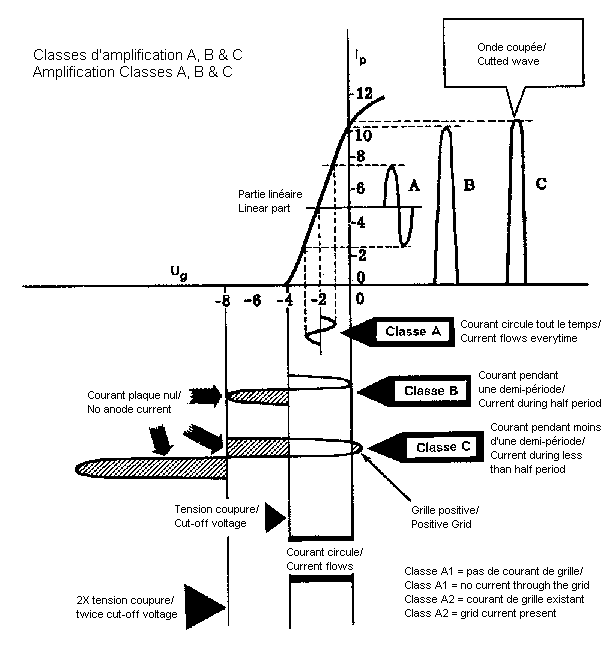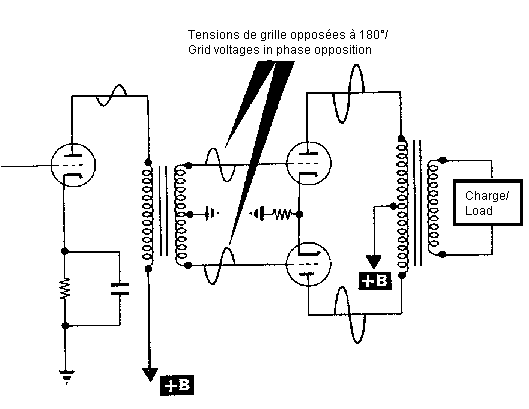
In all the previous examples, the amps were class A amps, but it is not the only way to use tubes/transistors and several other modes exist for the power stages and their drivers (stage preceding the power stage and able to furnish a small current).

This mode is ideal if you're looking for quality but its
efficiency is at best 50%, that means more than a half of the
power is lost in heat ...
Class A1 means that the power stage does not
absorb current from the previous stage, that's usually the case
with tubes without grid current and the field effect transistors.
Class A2 means that the power stage absorbs some
current from the previous stage, some tubes are used in this
manner and all the classic bipolar transistors.
Class A is the privileged amplification class for the purists
This class uses two power tubes mounted in a push-pull configuration. The efficiency is much higher but the distorsion too, the transition from one tube to the other is not perfect.

An additional circuit is needed to create the opposite wave
for the second tube, this is the phase splitter or phase inverter
task. In the upper example, a transformer is used but several
phase splitters types exist, a particular chapter is dedicated to
them.
In Hi-Fi, class AB is preferred for its lower distorsion.
To reduce the crossing distorsion, the class AB was invented.
Both tubes are conducting at low levels but alone, in class B,
when the level rises. It's a class used very often because of its
good compromise between acceptable efficiency and sonic
qualities.
It becomes nearly compulsory with the low-efficiency speakers we
can see to often nowadays.
It's a class not used in audio, it amplifies only the peaks of
the signal in a push-pull configuration.
It's always used in radio transmission because it has a very high
efficiency and only the peaks of the modulated radio frequency
needs to be amplified.
Class D, used by Sony, is an amplification
class where the power stage works with square waves which width
varies according to the signal. This modulation is obtained with
a high frequency triangle wave (>500KHz) superposed to the
audio signal. At every intersection, a side of the square wave is
obtained. Strong filtering is necessary to suppress the high
frequency before it reaches the loudspeakers and destroys them
...
There were so many problems and so few advantages (efficiency is
absolutely exceptionnal), this amplification class was quickly
abandonned. Well, not completely as I've recently seen
advertisements for amps using such a system.
Class G, used by Hitachi, is a sort of a class B combined to a class C where an additional stage of tubes/transistors with its own supply worked only during music peaks. This idea came after having noticed that the peaks in a music message are very short in duration, thus the idea of this class that lets the manufacturer save on the power supply. It had the same success as the D ...
Class H, used by Soundcraftsmen, is a class G where the voltage of the additional stage power supply varies with the signal.
I've probably missed some ...